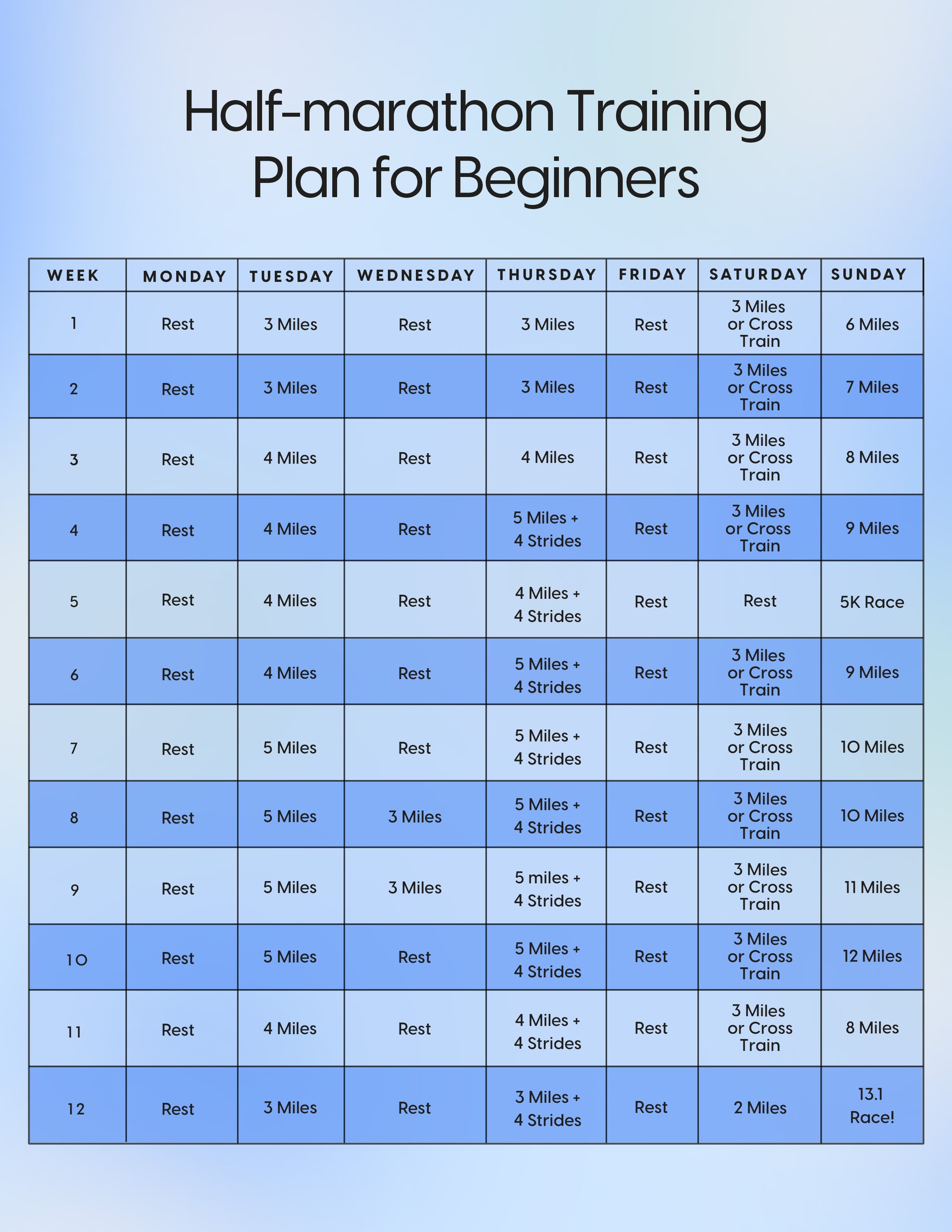Products You May Like

So you want to run your first half marathon? You’re going to need one thing: a desire to run … a lot. With the right approach, almost anyone can tackle 13.1 miles, but following a half-marathon training schedule for beginners is a major time commitment.
“To take on a half marathon, you have to really be excited for the training itself,” says founder of Wellness in Motion Run Coaching Amanda Nurse, a two-time Olympic marathon trials qualifier. Beginners will need to run about 15 to 30 miles a week for at least 12 weeks to get ready, clocking regular long runs that range from six to 12 miles, with cross-training in between.
If that doesn’t sound like something your legs can pull off just yet, don’t worry. It is possible to do a couch-to–half marathon safely; you’ll just need to give yourself extra time to train. “You need maybe a 20-week training plan where you’re really slowly building up the mileage,” Nurse says. Pick a race farther in the future, and start slowly working up to a solid base of running so that when you’re 12 weeks out, the beginning of the training plan feels doable.
Things To Know Before Starting This Half-Marathon Training Schedule for Beginners
As a UESCA-certified running coach, I created this 12-week beginner half-marathon training plan with three to five runs per week, building up to a 12-mile run two weeks before race day. You can see an easy outline of the plan below. But first, here are some need-to-know details.
How Fast to Run
All runs should be done at a relaxed pace that feels easy enough that you can comfortably chat with a running buddy the whole time. If you’re breathing too hard to do that, back off a bit. (Don’t be afraid to take a run-walk approach if you need.)
You might see veteran runners repeating speedy intervals on the track or talking about their pace goals for the race. But when it’s your first half marathon, don’t worry about going fast — just focus on getting used to going far. “For most people, running 13.1 miles is going to require being on your feet for two-plus hours,” Nurse says. More important than anything else is building the endurance to make it to the finish line.
The only time you’ll really pick up the pace is during the strides that start in week four to strengthen your form and challenge your fast-twitch muscle fibers. These should be done at the end of your run. Find a flat, safe stretch of path where you can build up to a fast speed for 10 to 20 seconds, then recover before doing the next one.
What to Know About Long Runs
The day before your long run, you can choose between a 3-mile run or 30-minute cross training session — that can be any form of cardio movement you like, whether it’s swimming, biking, or taking a cardio dance class. Just get your heart rate up.
Week five of the half-marathon training plan for beginners includes a 5K race in place of your long run. Really, any relatively short local race up to a 10K could work. The goal is to use this as a dress rehearsal to get familiar with the ins and outs of race day, like when to hit the porta potties and how to harness the adrenaline rush of the start line without going out too fast.
What to Eat On Long Runs
You’ll be using those long runs to train not just your legs and lungs, but also your gut. You’ll want to take in some carbohydrates during the race, and that takes practice. It can be awkward to run and eat at the same time, and your stomach needs to get used to digesting while you’re bouncing up and down.
It may take you some time to figure out what kind of fuel sits best in there. “Use your long runs like experiments to try out what works for you,” Nurse suggests. Plan on eating a small snack of simple carbs before you start running, then taking in about 100 calories from a gel or some gummies every 35 to 45 minutes, and washing it down with water. If there aren’t any water fountains on your route, carry a handheld bottle with you.
What to Know About Cross-Training
Throughout this half-marathon training schedule for beginners, you’ll also want to do some basic strength exercises regularly to make sure your muscles can handle 13.1 consecutive miles. Squats, lunges, deadlifts, calf raises, wall sits, planks, and clamshells are all great options. This doesn’t need to be lengthy; putting in just 10 minutes two or three times a week will do the trick. It’s best to do strength work after a run, but you can fit it in whenever works for you.
Just back off of strength training during the last couple of weeks before the race, called the taper period. You’ll notice the mileage also decreases during these weeks to help your legs feel fresh when you pull up to the starting line.
What to Do If You Can’t Stick to the Schedule Exactly
This plan is meant to be flexible — feel free to switch around the days during weeks when life gets a bit hectic. But respect your body: if you’re sick or injured, skip the run, and don’t try to “make up” for it the following week. The most important workout is the long run, so prioritize that if you have to choose. That said, more than any single run, it’s the overall consistency throughout the three months of training that will get you ready for race day.
A Half-Marathon Training Schedule For Beginners

